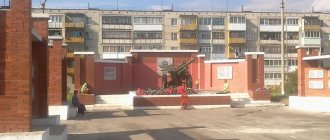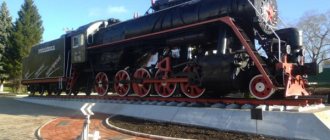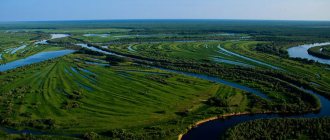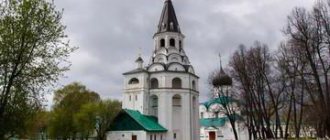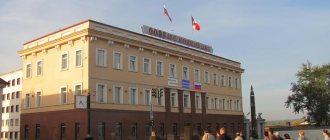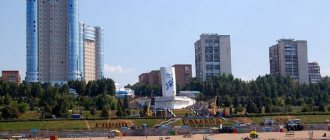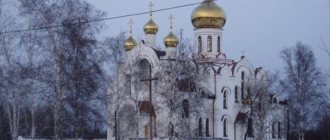Save it for yourselfPrint
Although not a major tourist center, Volgograd can impress with its great history, unique architectural structures and unusual location. Volgograd is a hero city that received this status thanks to the turning point Battle of Stalingrad.
Tsaritsyn, Stalingrad, and now Volgograd is a city on the Volga, more than 80 km long. Only in this city it takes more than 3 hours to get from one end of the city to the other. Most of the city's attractions are of a military nature, steeped in rich history and the terrible events of war.
Attractions
Tsaritsyn-Stalingrad-Volgograd
Approximately in 1555, a settlement was founded on the site of today's Volgograd. The first mention of a city called Tsaritsyn is found in historical materials starting in 1589.
Pier on the Volga
The name of the city comes from the Tsaritsa River flowing into the Volga. It was apparently based on the Tatar expression “sari-su”, meaning “yellow river” or “sari-chin”, which translates as “yellow island”. And this is explained by the fact that the Russian settlement that originally arose on the island of Tsaritsyn, which was a wooden fortress, was intended to defend a strategically important place on the Volga route, which is the junction of the Volga and Don, from robber gangs and steppe nomads roaming along the Volga banks.
The beginning of the 17th century became tragic for Tsaritsyn - the settlement burned down, and was subsequently rebuilt in 1615, only this time on the right side of the Volga, under the leadership of governor M. Solovtsov. Trade and embassy ships sailing under the flags of different states enjoyed the protection of the fortress. During the time of False Dmitry I, in 1606, Tsaritsyn was captured by the Volga Cossacks, who proclaimed one of them Tsarevich Peter. The Cossacks' further plans were to go to the capital, but at that moment False Dmitry died, and they had to abandon their intentions.
In 1667-1672 The Tsaritsyn garrison was on the side of Stepan Razin. In Tsaritsyn, salt and fish were traded quite briskly, and in 1691 a customs office opened here. The Don Cossacks, led by V. Bulavin and I. Nekrasov, briefly captured the city in 1707, but they were quickly driven out by government troops who arrived from neighboring Astrakhan.
In 1722 and 1723, a significant event took place for the city - Tsar Peter I visited it, and he liked the city so much that he decided to present it as a gift to his wife Catherine I. Another fire that destroyed Tsaritsyn occurred in 1727. Over the next four years, the city was rebuilt and strengthened again. It even received the high status of the center of the Volga-Don military line. Twice in 1774 the city was besieged by E.I. Pugachev, but resisted and did not give up.
Tsaritsyn panorama
Since 1708, Tsaritsyn was subordinate to the Kazan province, but during the 18th century he had to change his “nationality” several times, being assigned either to the Astrakhan province - from 1719, or to the Saratov governorship - from 1773. Since 1780, it acquired the status of a district town in the Saratov governorship (later - the province).
The beginning of the 19th century was marked by the emergence of industry - factories began to appear in Tsaritsyn one after another: candle and brick factories, mustard and beer factories. The city became the center of five post roads. And in 1862, the Volga-Don Railway was introduced between Tsaritsyn and Kalach-on-Don. In 1879, the railway service was extended to the city of Gryazi, and subsequently to Moscow. In 1897, with the help of railways, Tsaritsyn had a connection with the North Caucasus, passing through Tikhoretsk. In 1900, trains were already running between Tsaritsyn and Donbass.
The development of river shipping did not lag behind - many shipping companies had their agencies in Tsaritsyn. Since 1880, the largest oil storage facilities in Russia have been built here. In addition to merchant and passenger ships, the construction of large-capacity barges for transporting kerosene began. Woodworking also developed - by the beginning of the 20th century, there were only about 15 sawmills operating in the city. In general, at this time Tsaritsyn had already become one of the industrial centers of the country - more than 230 enterprises of various kinds operated in it. Among them are flour mills and woodworking, mustard, mechanical, iron foundries, salt mills and others. Banks were opened and the city was installed with telephones.
Infrastructure
The first type of public transport in Tsaritsyn in 1913 was the tram. Electric lighting in the form of lanterns appeared in the city center. 10 Orthodox churches and 1 Lutheran church, an Orthodox convent, as well as gymnasiums for men and women were opened.
To get an education, you could choose a city or vocational school. There were two public libraries and five printing houses in the city. Medical services were provided by two hospitals and the same number of outpatient clinics, as well as a zemstvo veterinary hospital, a bacteriological laboratory and a society of doctors. There was even a weather station. Three fairs were held every year during the summer. Trade was transit - cargo passed through the city by rail, heading to the Don, the Center of the country and the Ciscaucasia.
Renaming to Stalingrad
The civil war in 1918-1920 could not but have a negative impact on the development of the city, as fierce battles took place on its streets. After the end of the military vicissitudes, since 1920 Tsaritsyn became the “heart” of the province of the same name. And in 1925, it began to be called Stalingrad - in honor of the “leader of the peoples” who led the country at that time.
In 1928, the city became one of the district centers in the Lower Volga, and since 1932 - the center of the Lower Volga region. In 1934, the Lower Volga region was divided into Stalingrad and Saratov. In 1936, the Stalingrad region was transformed into a region. During the first five-year plans, existing enterprises were reconstructed, as well as new enterprises were built. Moreover, about fifty factories were built from scratch. Thus, in 1930, the country’s very first tractor plant appeared in Stalingrad, and a shipyard and StalGRES were also built. By 1940, 126 enterprises were already operating in the city.
“Volga on Fire” - Battle of Stalingrad
One of the main stages of the Great Patriotic War took place in Stalingrad and in the surrounding area. It began on July 17, 1942 with the offensive of the 6th German and 4th Tank Armies. And it ended on February 2, 1943 with the victory of our troops, who, having exhausted the main enemy group, did everything so that the Red Army could launch a counteroffensive.
Over the 200 days of the Battle of Stalingrad, the occupiers' losses in killed and wounded, missing and captured amounted to one and a half million people - this is a quarter of the total number of forces involved in the Nazi attack on the Soviet Union.
On May 1, 1945, Stalingrad received the honorary status of a hero city, and on May 8, 1965 it was awarded the Order of Lenin and the Golden Star.
Renaissance
During World War II, Stalingrad was almost wiped off the face of the earth. But immediately after its completion, the city was revived, it was practically rebuilt, industry and infrastructure were restored. In 1961, the hero city was renamed Volgograd.
Today the city is one of the most beautiful in Russia, with a distinctive and rich history. Volgograd is planned according to a linear system, which historically developed back in 1945.
Stretching from north to south along the banks of the Volga, the city is closed by the Volzhskaya Hydroelectric Power Station in the northern part and the Volga-Don Shipping Canal in the southwestern part. By the way, this canal provided Volgograd with the well-deserved title of a port of five seas.
Volgograd today
The city has an elongated shape, and its length is 90 km, with a total area of 56.5 thousand hectares. Volgograd is divided into 8 districts and a number of workers' settlements. Today, the cultural and industrial potential of the city has reached a very high level. It houses dozens of libraries, more than 20 universities and a unique planetarium.
Mamaev kurgan
The main memorial complex of the city, Mamayev Kurgan, is located in the north of the city. There are 200 steps from the beginning of the complex to the great statue, which is exactly how many days and nights the Battle of Stalingrad lasted.
“The Motherland Calls” has already become the calling card of the city; every Russian has heard about this unique building at least once. Its dimensions are amazing: 85 meters in height, weight more than 8,000 tons. Immediately after its construction in 1967, the statue was listed in the Guinness Book of Records as the tallest architectural structure; now it is only in 11th place.
Local government in the city of Volgograd
The transport and geographical location of the city provides the most important strategic functions for the socio-economic development of the southern region of the country. The combination of an existing powerful scientific base with higher education institutions with a wide range of specialization provides the prerequisites for global industrial restructuring and urban transformation based on advanced innovations.
A little history
Museums appeared in Volgograd “with the light hand” of Peter the Great, who during his visit presented the townspeople with his cap and cane as a gift. They became the first museum relics of the city.
The first tram lines appeared in Volgograd, which during the Russian Empire was called Tsaritsyn. By the way, this name did not arise at all as a result of an attempt to dedicate an entire city to the royal person - it was just that the Turkic words “Sary-chin”, meaning a beautiful or yellow island, were somewhat distorted in Russian. The very first enterprise that appeared in the city in time immemorial was a mustard factory.
During the uprising of Stepan Razin, his troops first captured Tsaritsyn, although the gates were opened to the ataman by the archers, most of whom went over to his side. But during the rebellion of Emelyan Pugachev, the situation was the opposite - Tsaritsyn remained the only city that did not surrender.
Who and when wanted to return the old names to the city?
Disputes about renaming Volgograd back to Stalingrad or Tsaritsyn have been going on for a long time. This issue has been discussed several times in the media. Communists usually advocate returning the name Stalingrad to the city. In addition to the communists, for some reason residents of St. Petersburg collected signatures in support of this initiative, which surprised the Volgograd residents themselves. Another part of the residents periodically asks to return the pre-revolutionary name of Tsaritsyn to Volgograd.
However, many citizens do not support the initiative to rename the city. For 50 years they have become quite accustomed to the name Volgograd and would not want to change anything.
What plants grow in the Volgograd region?
Flora of the Volgograd region
Forbs of astragalus, sage and other plants
. In spring, the steppe is covered with carpets of red and yellow tulips, later it will become dark purple and intoxicating with blooming sage, and then the endless plains will turn gray with feather grass.
Interesting materials:
What date and month is Medical Worker Day? What date is Medical Worker's Day? What date is Medical Worker's Day in June? Which accounting entry reflects the calculation of wages to employees of primary production? What should be the lunch break in a 12 hour work day? How long must you work to get a loan? What should be the minimum area per workstation for PC users based on flat discrete LCD plasma screens? What should be the duration of continuous work on a personal computer without a regulated break? In what form is the employer obliged to familiarize the employee with the results of a special assessment of working conditions at his workplace? What is the work schedule for truck drivers?

